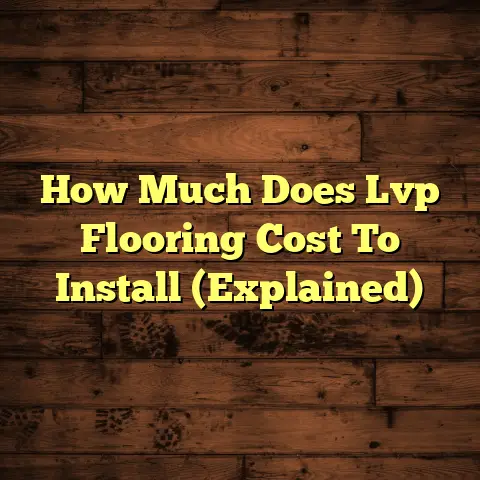LVT Over Ceramic Tile? (6 Install Fails!)
When it comes to flooring, is it style that matters more, or the practicality of installation?
It’s a question that’s crossed the minds of many homeowners, especially with the rising popularity of Luxury Vinyl Tile (LVT).
LVT’s aesthetic appeal and versatility make it a hot commodity. But what happens when you consider installing LVT over existing ceramic tile?
It sounds like a dream – saving time and demolition costs. But trust me, as a flooring contractor with years in the trenches, it’s a path riddled with potential pitfalls.
Let’s dive deep into the world of LVT over ceramic, and I’ll share the six most common install fails I’ve witnessed (and sometimes, sadly, had to fix!).
Understanding LVT and Its Advantages
So, what exactly is Luxury Vinyl Tile (LVT)?
Think of it as the chameleon of the flooring world. It’s a multi-layered synthetic flooring product designed to mimic the look of natural materials like wood, stone, or, yes, even ceramic tile!
It’s typically composed of:
-
A wear layer: This is your shield against scratches, stains, and everyday wear and tear.
-
A print layer: This is where the magic happens – the high-resolution image that gives LVT its realistic appearance.
-
A core layer: This provides stability and helps resist indentation.
-
A backing layer: This adds cushioning and helps with sound absorption.
Why is LVT so popular? Let me count the ways:
-
Durability: LVT can withstand heavy foot traffic, making it ideal for busy households.
-
Ease of Maintenance: Spill? No problem! LVT is water-resistant and easy to clean.
-
Design Versatility: From rustic wood planks to sleek stone looks, LVT offers a design for every taste.
-
Cost-Effectiveness: Compared to natural materials, LVT is generally more budget-friendly.
But here’s the kicker: Many homeowners are choosing to install LVT over their existing ceramic tile.
Why go this route instead of ripping out the old tile? That’s what we’ll explore next.
The Appeal of Installing LVT Over Ceramic Tile
Let’s face it: demolition is a pain. It’s messy, time-consuming, and expensive.
That’s why the idea of installing LVT directly over existing ceramic tile is so appealing.
Here are the main reasons behind this trend:
-
Cost-Effectiveness: Skipping demolition saves on labor costs, disposal fees, and potential damage to surrounding areas.
-
Time-Saving: No demolition means a faster installation process, getting you back to enjoying your space sooner.
-
Minimizing Waste: Reusing the existing tile substrate is an environmentally friendly choice.
According to a 2023 survey by the National Association of Home Builders (NAHB), approximately 30% of homeowners who installed new flooring opted to install it over existing flooring, with LVT being a popular choice. [^1^]
This approach seems like a no-brainer, right? But hold on! Before you grab your LVT and adhesive, let’s talk about the potential pitfalls.
I’ve seen too many DIY projects (and even some professional jobs) go south because of these common mistakes.
Common Install Fail #1: Inadequate Surface Preparation
This is, without a doubt, the biggest mistake I see.
Think of it this way: your existing ceramic tile is the foundation for your new LVT floor.
If that foundation is flawed, your LVT installation is doomed from the start.
Here’s what inadequate surface preparation looks like:
-
Failing to Clean the Ceramic Tile Properly: Dust, dirt, grease, and old adhesive residue can prevent the LVT adhesive from bonding properly.
Imagine trying to stick tape to a dusty surface – it just won’t hold!
-
Not Addressing Cracks or Damaged Tiles: Even small cracks in the ceramic tile can telegraph through to the LVT over time, creating unsightly lines and potential weak spots.
Loose or broken tiles need to be repaired or replaced before you even think about installing LVT.
-
Ignoring Uneven Surfaces: Ceramic tile floors are rarely perfectly level. Dips, bumps, and uneven grout lines can create an uneven surface for the LVT, leading to a less-than-perfect finish.
The Fix:
-
Thoroughly clean the ceramic tile: Use a heavy-duty cleaner and scrub brush to remove all dirt, grime, and residue. Rinse well and allow to dry completely.
-
Repair or replace damaged tiles: Use a thin-set mortar to repair cracks and replace any loose or broken tiles.
-
Level the surface: Use a self-leveling underlayment to create a smooth, even surface for the LVT. This is crucial for achieving a professional-looking result.
I once worked on a project where the homeowner skipped the self-leveling step. Within a few months, the LVT started to buckle and lift in several areas.
The cost of redoing the entire floor far outweighed the initial cost of the self-leveling underlayment.
Don’t make the same mistake!
Common Install Fail #2: Ignoring Height Differences
Okay, let’s talk about transitions.
You’ve got your beautiful new LVT floor installed over the ceramic tile. But what happens when it meets the adjacent floor, like carpet or hardwood?
If you haven’t accounted for the height difference between the LVT and the adjoining floor, you’re in for trouble.
Here’s why height differences matter:
-
Tripping Hazards: A significant height difference can create a tripping hazard, especially for young children or elderly individuals.
-
Uneven Transitions: An abrupt transition between two different floor heights looks unprofessional and can detract from the overall aesthetic.
-
Door Clearance Issues: The added height of the LVT can prevent doors from opening and closing properly.
The Fix:
-
Measure the height difference: Use a level and measuring tape to determine the exact height difference between the LVT and the adjoining floor.
-
Use transition strips: Transition strips are designed to bridge the gap between two different floor heights, creating a smooth and safe transition.
There are various types of transition strips available, so choose one that is appropriate for the specific height difference and flooring materials.
-
Consider feathering: Feathering involves gradually ramping up the height of the subfloor to create a more gradual transition. This is a more advanced technique that may require the help of a professional.
I remember a client who insisted on skipping the transition strips to save money. Within a week, her elderly mother tripped over the uneven transition and suffered a minor injury.
The cost of the medical bill and the emotional distress far outweighed the cost of the transition strips.
Safety should always be your top priority!
Common Install Fail #3: Poor Adhesive Selection
Adhesive: it’s the unsung hero (or villain) of any flooring installation.
Choosing the wrong adhesive can lead to a whole host of problems, from loose tiles to adhesive failure.
Here’s what can go wrong when you skimp on adhesive:
-
Using the Wrong Type of Adhesive: Not all adhesives are created equal. Some are designed for specific types of flooring or subfloors.
Using an adhesive that is not compatible with LVT or ceramic tile can result in a weak bond and premature failure.
-
Applying Too Little Adhesive: Skimping on adhesive to save money is a recipe for disaster. Insufficient adhesive can lead to loose tiles and a hollow sound when you walk on the floor.
-
Applying Too Much Adhesive: On the other hand, applying too much adhesive can create a mess and prevent the LVT from properly adhering to the subfloor.
The Fix:
-
Choose the right adhesive: Consult with a flooring professional or read the LVT manufacturer’s recommendations to determine the best adhesive for your specific project.
Look for an adhesive that is specifically designed for LVT installation over non-porous surfaces like ceramic tile.
-
Apply the adhesive correctly: Follow the manufacturer’s instructions for adhesive application, including the recommended spread rate and open time.
-
Use a notched trowel: A notched trowel helps to ensure even adhesive distribution and proper bonding.
I’ve seen countless projects where the homeowner used a cheap, all-purpose adhesive in an attempt to save money.
Within a few months, the LVT started to peel up around the edges, and the floor had to be completely replaced.
Investing in the right adhesive is an investment in the longevity of your floor.
Common Install Fail #4: Improper Acclimation of LVT
Acclimation: it’s a fancy word for letting your LVT adjust to the temperature and humidity of your home before installation.
Skipping this step can have serious consequences, especially in areas with fluctuating temperatures or humidity levels.
Here’s why acclimation is so important:
-
Expansion and Contraction: LVT, like any material, expands and contracts with changes in temperature and humidity.
If you install LVT before it has had a chance to acclimate, it may expand or contract after installation, leading to buckling, warping, or gapping.
The Fix:
-
Acclimate the LVT: Store the LVT in the room where it will be installed for at least 48-72 hours before installation.
Make sure the room is at a normal living temperature (between 65°F and 75°F) and humidity level.
-
Follow the manufacturer’s instructions: Some LVT manufacturers may have specific acclimation recommendations, so be sure to read the instructions carefully.
I once installed LVT in a sunroom without acclimating it properly. The sunroom was significantly warmer than the rest of the house.
Within a few days, the LVT started to buckle and warp due to the temperature difference.
I had to remove the entire floor and reinstall it after properly acclimating the LVT.
Learn from my mistake: don’t skip the acclimation step!
Common Install Fail #5: Neglecting Expansion Gaps
Expansion gaps: those small spaces around the perimeter of the room that allow the LVT to expand and contract without putting pressure on the walls.
Ignoring these gaps can lead to some serious problems down the road.
Here’s why expansion gaps are essential:
-
Buckling and Warping: When LVT expands without room to move, it can push against the walls, causing the floor to buckle or warp.
-
Cracking and Damage: The pressure from the expanding LVT can also cause the ceramic tile underneath to crack or become damaged.
The Fix:
-
Leave an expansion gap: Leave a 1/4-inch to 3/8-inch expansion gap around the perimeter of the room when installing LVT.
-
Use spacers: Use spacers to maintain the proper expansion gap while installing the LVT.
-
Cover the gaps: Cover the expansion gaps with baseboards or quarter-round molding to create a finished look.
I worked on a project where the homeowner installed LVT tight against the walls, without leaving any expansion gaps.
During the summer months, the LVT expanded and started to push against the walls.
The pressure caused the baseboards to buckle and the ceramic tile underneath to crack.
I had to remove the baseboards, cut back the LVT, and install new baseboards to fix the problem.
Don’t underestimate the power of those little gaps!
Common Install Fail #6: Skipping the Underlayment
Underlayment: that thin layer of material that sits between the subfloor and the flooring.
While not always required for LVT installations over ceramic tile, skipping the underlayment can have some noticeable consequences.
Here’s why you might want to consider underlayment:
-
Noise Reduction: Underlayment can help to absorb sound, making your floor quieter and more comfortable to walk on.
-
Added Comfort: Underlayment provides a layer of cushioning underfoot, making the floor feel softer and more comfortable.
-
Moisture Barrier: Some underlayments can act as a moisture barrier, protecting the LVT from moisture that may be present in the subfloor.
The Fix:
-
Consider using underlayment: If you’re concerned about noise, comfort, or moisture, consider using an underlayment specifically designed for LVT installations.
-
Choose the right underlayment: Look for an underlayment that is compatible with LVT and ceramic tile.
I had a client who decided to skip the underlayment to save money. She quickly regretted her decision.
The floor was noisy and uncomfortable to walk on, and she could hear every footstep in the room below.
She ended up having to remove the LVT and install underlayment, which was a costly and time-consuming process.
While underlayment may not always be essential, it can make a big difference in the overall comfort and performance of your LVT floor.
Conclusion:
So, there you have it: the six most common install fails I’ve seen when it comes to installing LVT over ceramic tile.
Remember, proper surface preparation, accounting for height differences, choosing the right adhesive, acclimating the LVT, leaving expansion gaps, and considering underlayment are all crucial for a successful installation.
By avoiding these common mistakes, you can ensure a beautiful, lasting floor that you’ll enjoy for years to come.
Don’t be afraid to ask for help from a flooring professional if you’re unsure about any aspect of the installation process.
A little bit of planning and preparation can go a long way in preventing costly mistakes and ensuring a successful LVT installation.
Happy flooring!
[^1^]: National Association of Home Builders (NAHB) 2023 Remodeling Market Index.





